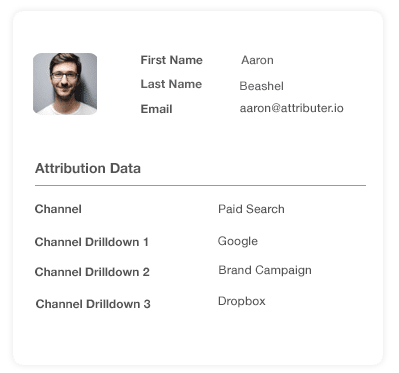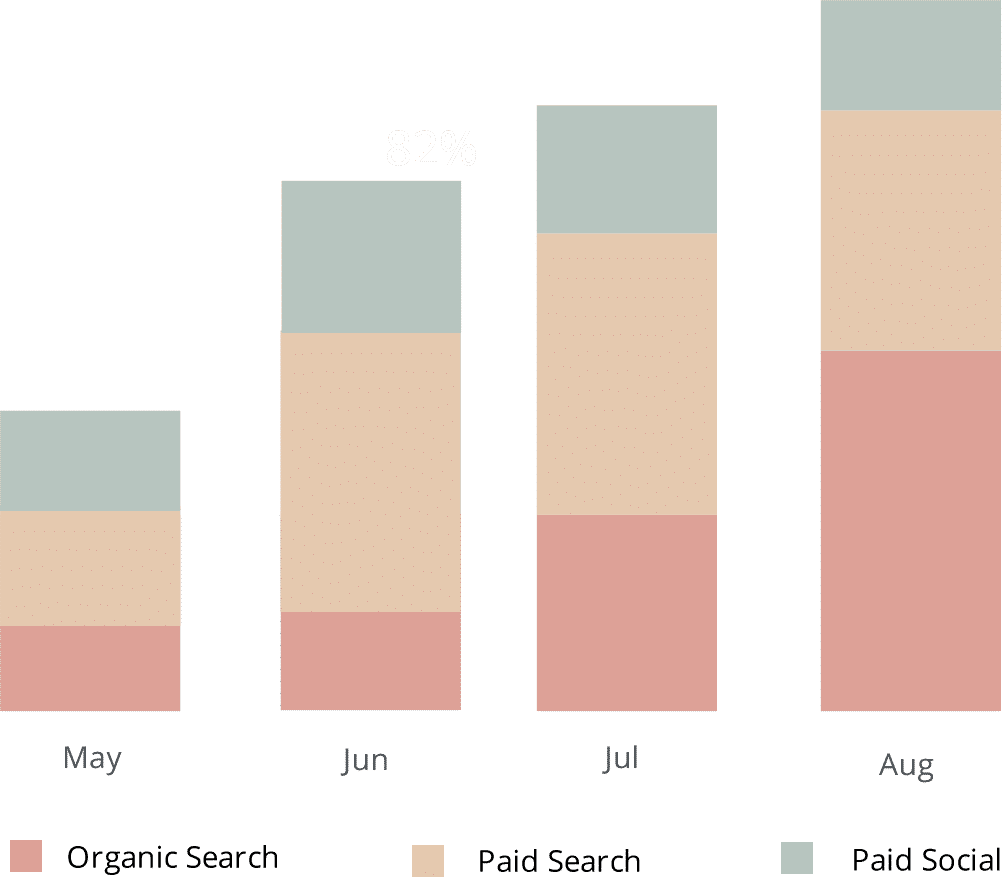The best way to track UTM parameters in Kissmetrics
Learn how to capture UTM parameters and other marketing attribution information so you can run reports in Kissmetrics that show you what's driving your leads, customers and revenue.

Kissmetrics is one of the many excellent analytics tools that lets you create reports and dashboards to see how your business performs.
However, Kissmetrics' performance is only as good as the data you feed it. You also need to capture and send UTM parameters into Kissmetrics to run reports that provide insight into your marketing efforts' performance.
Do you know how to do this? Don't fret if you don't, as this article will show you 4 simple steps to capture and send UTM parameters to Kissmetrics using a simple tool called Attributer.
What is Attributer?
In the most basic sense, Attributer is a small snippet of code that you add to your site.
Once it's working, Attributer will monitor every visitor that reaches your site and determine where they have come from (i.e., the UTM parameters in the URL). Once their origin is known, Attributer then groups each visitor according to a series of channels (e.g: organic search, paid search, paid social, etc.) and stores this information in the user's browser as a cookie.
Once a visitor decides to submit a form on your site, Attributer sends the UTM parameters and other marketing attribution data into your CRM or other backend tools. From here, the data can now be passed into Kissmetrics for analysis.
When the data has reached Kissmetrics, you can create reports that will provide answers to questions like:
- How many customers have I generated from my Facebook ads?
- What's the average deal size of customers from my Facebook ads vs. customers from my Google ads?
- What's the total revenue generated from our Facebook ad campaigns?
- What's the overall ROI of our ads?
4 steps for adding UTM parameters to Kissmetrics
Using Attributer to get UTM parameters into Kissmetrics is easy. Here's how to do it in 4 easy steps:
1. Add UTM variables to your ads

UTM parameters must be added to your ads and campaigns first to provide Attributer the platform it needs to determine where your traffic is coming from.
This includes your ads on social networks like Twitter, Facebook and LinkedIn, in search engines like Bing and Google, and in bespoke campaigns in trade publications.
2. Add the Attributer code to your website

Once the UTM parameters have been added, you need to add the Attributer code to your website.
Once you've successfully signed up for a free trial, a small piece of code will be provided for you to add to your site. This code is very much like the Google Analytics code and other marketing tools' code and should be added the same way as them too.
Adding the code to your website largely depends on the CMS system you use (i.e., WordPress, Wix, etc.). However, it is common for these systems to provide an option to add the code to the header in the Settings area.
On the other hand, if you're using a tag management service like Tealium, you may directly add the code through this tool.
If you need further assistance in adding the code to your site, simply check out our help site.
3. Send the data to Kissmetrics

Once the code has been added to your site, Attributer will monitor how your visitors arrive at your site. Once the visitor's origin has been determined, Attributer will then categorise them according to channels (e.g: organic search, paid search, etc.) and store this data in the user's browser as a cookie.
In order to send the data to Kissmetrics, you need to extract the data out of the cookie. There are two ways to do this:
- Adding hidden fields in forms - By adding hidden fields to your forms, Attributer will have a place to write the data. Once the form is submitted, this data is sent to Kissmetrics along with the user's other information (name, email, etc.)
- Take the data out of the cookie - Through adding a simple line of javascript to your site's forms, you will be able to retrieve the UTM parameters from the Attributer cookie and pass them into Kissmetrics. This method is beneficial if you have the 'Sign up with Google' or 'Sign up with Facebook' buttons that allow users to sign up for your product without filling up a form. There's an article to help you do this here.
4. Run reports in Kissmetrics

Once the UTM parameters and other attribution data are in Kissmetrics, you can start building reports and dashboards to determine how your marketing efforts are performing.
Having detailed reports and data organised into channels or campaigns will help you answer questions such as:
- How many signups did I get from my Google ads?
- Which Twitter ad campaigns drove the most signups?
- How many customers came from our Facebook ads?
- Which LinkedIn ad campaigns drove the most customers?
- How many customers have we gotten from our SEO efforts?
- How much revenue has come from our blogging efforts?
- And much more
Why using Attributer is better than capturing raw UTM parameters
There are plenty of choices for capturing UTM parameter tools, but Attributer is different.
How?
Simply because Attributer can do a lot more than just collect UTM parameters. It can also do the following:
1. Captures all traffic
Besides capturing UTM parameters and passing them into Kissmetrics, Attributer also collects the visitors' channel data for people who have reached your site through channels where UTM parameters weren't present (i.e., organic social, paid social, direct, referral, etc.)
This means that you will have insight into your every customer's origin instead of just the visitors from campaigns with UTM parameters.
2. Remembers the data
Requiring the UTM parameters to actually be present on the page where the form is submitted is the prevailing practice for most UTM parameter capturing tools and methods. This practice can be a problem because the page where a user completes the form isn't the exact page they landed on.
For example, a user clicks on your Google ad and is brought to the landing page you assigned for this campaign.
After they've read and explored, they've decided that they want your product or service and proceed to click on the 'Create An Account' button. Upon clicking, the user is then led to a different page to complete your signup form. This means that the page they complete a form is not the same page they first arrived on, which equates to losing the UTM parameters.
With Attributer, losing the UTM parameters isn't possible because Attributer stores the UTM parameters in a cookie in the user's browser. Hence, regardless of the user's navigation activity before completing a form, the UTM parameters are secured and will always be passed through.
3. Provides cleaner data
Working with UTM parameters, the data can get very messy. This especially happens if your ads have been handled by different people or agencies over time.
For example, some of your Facebook ad campaigns are tagged with UTM_Source=Facebook (capitalized), others with UTM_Source=facebook (uncapitalized), and others with UTM_Source=fb.
With these tags, other UTM capturing tools will have the incorrect data passed to Kissmetrics. And if you try to run a report based on the data captured by other tools, the results would show up as 3 different sources, and you'd be provided with the wrong information.
Attributer, on the other hand, is built to expect these types of inconsistencies and can categorise these leads to the correct channel (paid social) regardless.
4. Captures landing page data as well
It's only natural for dedicated business owners and marketers to want to know how their efforts are fairing. Thoughts like wanting to see how many leads and customers have been generated from your blog and those other in-depth content you've spent hours on.
Attributer can help with this as it not only captures UTM parameters and other channel data but also captures the landing page (i.e., attributer.io/blog/capture-utm-parameters) and the landing page's category (i.e., /blog).
With this information, you will be able to monitor the performance of specific sections on your website (blog) and individual pages (single blog post) regarding the generation of leads, customers and revenue.
Wrap up
With so much more to offer, Attributer is more than your average UTM capturing tool. The work Attributer does may not be seen straight away, but with detailed and more accurate results, better insights are guaranteed.
Apart from the usual UTM parameters, Attributer also collects all your incoming traffic data, secures essential data regardless of the user's navigation activity around your site, and organises the data to ensure the effortless running of reports and accurate results.
Want to see for yourself what Attributer can do for you? Start your 14-day free trial today and determine if it fits your needs.
Get Started For Free
Start your 14-day free trial of Attributer today!

About the Author
Aaron Beashel is the founder of Attributer and has over 15 years of experience in marketing & analytics. He is a recognized expert in the subject and has written articles for leading websites such as Hubspot, Zapier, Search Engine Journal, Buffer, Unbounce & more. Learn more about Aaron here.
